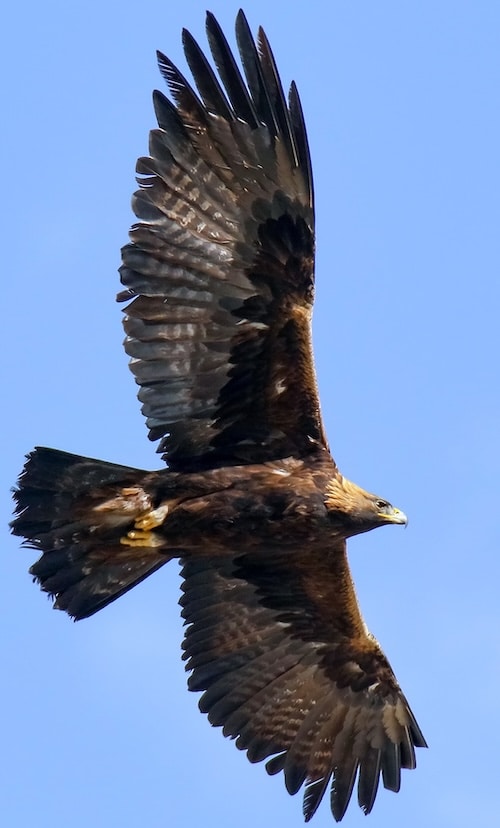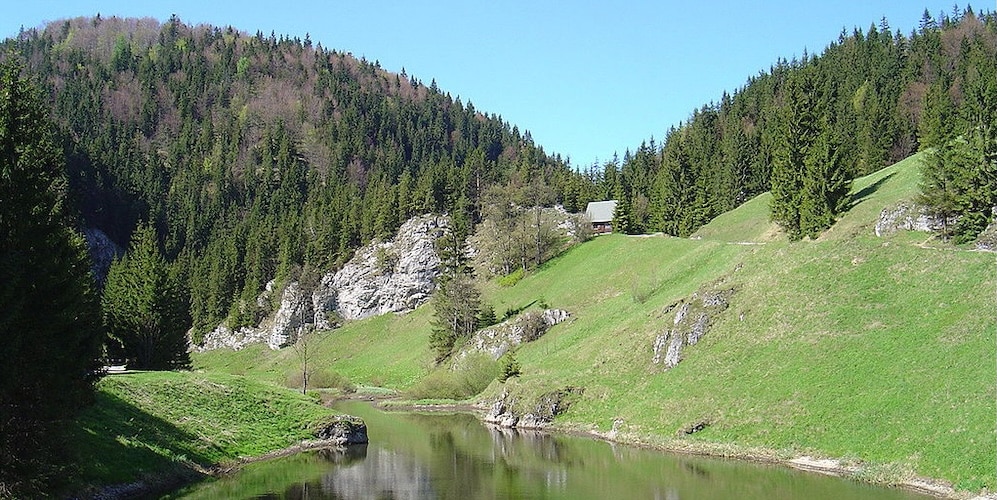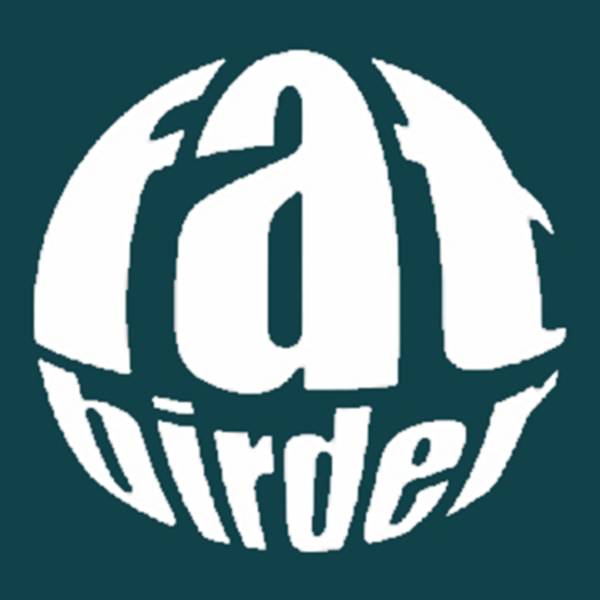Slovak Republic

Slovakia is a landlocked country in Central Europe. It is bordered by Poland to the north, Ukraine to the east, Hungary to the south, Austria to the west, and the Czech Republic to the northwest. Slovakia’s mostly mountainous territory spans about 49,000 km2 (19,000 square miles), hosting a population of about 5.5 million. The capital and largest city is Bratislava with about half a million residents and the second largest is Košice. The Slovak landscape is noted primarily for its mountainous nature, with the Carpathian Mountains extending across most of the northern half of the country. Among these mountain ranges are the high peaks of the Fatra-Tatra Area (including Tatra Mountains, Greater Fatra and Lesser Fatra), Slovak Ore Mountains, Slovak Central Mountains or Beskids. The largest lowland is the fertile Danubian Lowland in the southwest, followed by the Eastern Slovak Lowland in the southeast. Forests cover over 40% of Slovak land surface.
The Tatra Mountains, with 29 peaks higher than 8,200 feet above sea level, are the highest mountain range in the Carpathian Mountains. They occupy an area of 750 km2 (290 square miles), of which the greater part 600 km2 lies in Slovakia. They are divided into several parts. To the north, close to the Polish border, are the High Tatras, home to many scenic lakes and valleys as well as the highest point in Slovakia, the Gerlachovský štít at 8,711 feet and the country’s highly symbolic mountain Kriváň. To the west are the Western Tatras and to the east are the Belianske Tatras, smallest by area. Separated from the Tatras proper by the valley of the Váh river are the Low Tatras. The Tatra mountain range is represented as one of the three hills on the coat of arms of Slovakia. Slovakia has hundreds of caves and caverns under its mountains, of which 30 are open to the public.

Lake and Tatra Mountain – ©Ingo Mehling CC BY-SA 4.0 via Wikimedia Commons
Most of the rivers rise in the Slovak mountains. Some only pass through Slovakia, while others make a natural border with surrounding country. For example, the Dunajec to the north, the Danube to the south or the Morava to the West. The total length of the rivers on Slovak territory is almost 50,000 kilometres. The longest river in Slovakia is the Váh (403 kilometres or 250 miles), the shortest is the Čierna voda. Other important and large rivers are the Myjava, the Nitra, the Orava, the Hron, the Hornád, the Slaná and the Ipeľ (forming the border with Hungary), the Bodrog, the Laborec, the Latorica and the Ondava.
The Slovak climate lies between the temperate and continental climate zones with relatively warm summers and cold, cloudy and humid winters. Temperature extremes are between −41 and 40 °C although temperatures below −30 °C are rare. The weather differs from the mountainous north to the plains in the south. The warmest region is around Bratislava and Southern Slovakia where the temperatures may reach 30 °C in summer. During night, the temperatures drop to 20 °C. The daily temperatures in winter average in the range of −5 °C to 10 °C. During night it may be freezing, but usually not below −10 °C. There are four seasons each lasting three months. The dry continental air brings in the summer heat and winter frosts. In contrast, oceanic air brings rainfalls and reduces summer temperatures. In the lowlands and valleys, there is often fog, especially in winter.
The geographical position of Slovakia determines the richness of the diversity of fauna and flora. More than 11,000 plant species have been described throughout its territory, nearly 29,000 animal species. Endemic biodiversity is also common. It is located in the biome of temperate broadleaf and mixed forests and terrestrial ecoregions of Pannonian mixed forests and Carpathian montane conifer forests. As the altitude changes, the vegetation associations and animal communities are forming height levels (oak, beech, spruce, scrub pine, alpine meadows and subsoil).

Rakytov Mountain in Veľká Fatra National Park – ©David Paloch (Caroig) CC BY-SA 2.5 via Wikimedia Commons
There are nine national parks in Slovakia, covering 6.5% of the Slovak land surface. These parks are: Tatra National Park, Low Tatras National Park, Veľká Fatra National Park, Slovak Karst National Park, Poloniny National Park, Malá Fatra National Park, Muránska planina National Park, Slovak Paradise National Park and Pieniny National Park.
Birding Slovakia
As Slovakia is essentially a land of mountains; high, snow-capped, rugged, often wild mountains; birding here often involves some walking, if not trekking, and the mountains and forests do not always give up their delights easily. But delights there are: Eagle, Ural, Pygmy and Tengmalm’s Owls, Three-toed, White-backed, Middle Spotted, Grey-headed and Black Woodpeckers, Black Stork, Booted, Lesser-spotted, Imperial and Golden Eagles, Black Grouse, Hazel Grouse, Ring Ouzel, Red-breasted Flycatcher, Nutcracker, Common Rosefinch, Alpine Accentor and the enticing Wallcreeper to mention just a few. Though one invariably needs local expertise, incredible luck, or a combination of the two to see them, there are also Brown Bear, Lynx and Wolf in many of Slovakias forested mountain ranges. At the highest elevations, often accessible by cable-car or ski-lift, Chamoix and Marmots are often quite easy to see.

Stužica Primeval Forest – ©David Paloch (Caroig) CC BY-SA 2.5 via Wikimedia Commons
The Pieniny, Mala (Little) Fatra, Nizke (Low) Tatry and the rugged High Tatras are all typical ranges with dense broad-leaved forests at lower levels, mixed beech and conifer higher up, then spruce and alpine zones of dwarf pine and boulder-country around their peaks. But one must be prepared for sudden changes in weather and carry the right equipment, supplies and clothing when birding these mountains. In the very east of the country the Slanske Hills and Vihorlat Range are particularly good woodland birding areas, which are not as rugged as the higher ranges and include some old virgin beech-spruce forests particularly good for White-backed Woodpecker. Here in the east, too, there are stable, if not increasing, populations of Saker and Imperial Eagle and in the very northeast the ranges of Thrush Nightingale and Common Nightingale meet.
Another fine area is the Slovensky Kras, a scenic karst, hilly region of gorges, broadleaved woods, scrub and meadows bordering Hungary, with Rock Thrush, Rock Bunting, a good selection of raptors and most of the woodpeckers. Besides mountains and forests Slovakia also boasts some fine lowland habitats, mainly along the Danube flood-plain bordering Hungary. The last Great Bustards in Slovakia hang on here: birds such as White Stork, Syrian Woodpecker, Short-toed Treecreeper, Red-backed Shrike, Golden Oriole, Serin and Icterine, River & Barred Warblers are fairly common in suitable habitat. In the southeast corner of the country, the Senne fish-ponds and surrounding agricultural land and grasslands have a bird life more akin to the Hungarian Plain to the south – such as Little Egret, Purple Heron, Little Bittern, Spoonbill, Whiskered Tern, Red-footed Falcon, Bee-eater and Lesser Grey Shrike; and it has a reputation for turning up rarities.

Slovak Paradise National Park – ©Kristo via Wikimedia Commons
Slovakia is a long narrow country, which stretches from its capital Bratislava in the very southwest, up against the Austrian border, to the Ukraine in the far east. To the north there is Poland, to the south Hungary and, to the immediate west, the Czech Republic. There is an airport at Bratislava, but few international carriers land there. A better flight option is nearby Vienna or Budapest in neighbouring Hungary. A very organised outdoor, and in particular winter, sport-based tourist industry means that almost wherever one finds oneself in Slovakia there is no shortage of accommodation, invariably inexpensive, ranging from hotels proper, newly established bed & breakfasts, zimmer-frei, camp-sites at lower elevations, mountain chalets and basic but well-placed cabins. Indeed, besides boasting some of Europe’s best mountain scenery Slovakia also remains one of Europe’s most affordable countries to visit.
-
Gerard Gorman
| gerard@probirder.com
http://www.probirder.com
-
Number of bird species: 378
(As at April 2025)National Bird: Golden Eagle Aquila chrysaetos
-
Avibase
PDF ChecklistThis checklist includes all bird species found in Slovakia , based on the best information available at this time. It is based on a wide variety of sources that I collated over many years. I am pleased to offer these checklists as a service to birdwatchers. If you find any error, please do not hesitate to report them. -
Bird Watching Slovakia
PDF ChecklistHere you can find the detailed Checklist of birds of Slovakia... -
E-Bird
PDF ChecklistThis checklist is generated with data from eBird (ebird.org), a global database of bird sightings from birders like you. If you enjoy this checklist, please consider contributing your sightings to eBird. It is 100% free to take part, and your observations will help support birders, researchers, and conservationists worldwide. -
Wikipedia
Annotated ListThis is a list of the bird species recorded in Slovakia. The avifauna of Slovakia include a total of 378 species, of which 4 have been introduced by humans. 21 species are globally threatened.
-
Birds of Europe, North Africa, and the Middle East
| Photographic Guide | By Frédéric Jiguet & Aurélien Audevard | PUP | 2017 | Paperback | 447 pages, 2200 colour photos, colour distribution maps | ISBN: 9780691172439 Buy this book from NHBS.com -
Collins Bird Guide
| By Lars Svensson | Harper Collins | Edition 3 | 2023 | Paperback | 478 pages, 4000+ colour illustrations, 700 colour distribution maps | ISBN: 9780008547462 Buy this book from NHBS.com

Collins Bird Guide
AndroidThe Collins Bird Guide App provides everything you need to identify a species quickly and learn about it thoroughly.
Collins Bird Guide
Apple iOS |Collins Bird Guide 4+ A field guide to Europe NatureGuides Ltd. Designed for iPadOrganisations-
Slovak Ornithological Society - BirdLife Slovakia
WebsiteSOS / BirdLife Slovakia is a nongovernmental organisation. Our mission is to research and to protect nature, mainly birds and their biotopes in Slovakia. -
Slovak Wildlife Society
WebsiteWe are a not-for-profit organisation focused on wolf, bear and lynx. We work with local communities, providing practical and financial assistance to reduce human-wildlife conflicts. We conduct research and education and specialise in combining ecotourism, wildlife monitoring and conservation.
Reserves-
*National Parks of Slovakia
InformationSatellite ViewInteractive links to the nine national parks... -
*Protected Areas of Slovakia
InformationSatellite ViewInteractive list of National Nature Reserves, etc... -
Czech Biosphere Reserves Network
InformationSatellite ViewCzechoslovak National MAB Committee… -
NP BR Poloniny (East Carpathian Biosphere Reserve)
InformationSatellite ViewThe East Carpathian Biosphere Reserve is a transboundary protected area, designated as an area of global importance under UNESCO's Programme on Man and the Biosphere. It is located in the Eastern Carpathians and includes parts of three countries: Poland, Slovakia and Ukraine. Poloniny National Park in northeastern Slovakia at the Polish and Ukrainian borders. It is home to around 198 bird species. -
NP Slovak Karst
InformationSatellite ViewSlovak Karst National Park is a national park in the Slovak Karst (Slovenský kras) mountain range in South East Slovakia. It lies in the Gelnica, Rožňava and Košice–okolie districts in the Košice region. -
NP Slovenský Raj (Slovak Paradise)
InformationSatellite ViewThe National Park Slovak Paradise is situated in the eastern part of Slovakia. In 1964 it was proclaimed the Protected Landscape Area and in 1988 recategorised by the government imposition to be the National Park. The park covers the area of 19,763ha (197,63km2) and the protected zone 13,011ha (130,11km2). -
NP Tatra
InformationSatellite ViewTatra National Park is one of the nine national parks in Slovakia. It is situated in North Central Slovakia in the Tatra Mountains. The park is important for protecting a diverse variety of flora and fauna, with many endemic species, including the Tatra chamois. There are 115 species of birds, 42 mammals, 8 reptiles, and 3 amphibians. -
Wetlands
InformationSatellite ViewThe convention entered into force in Slovakia on 1 January 1993. Slovakia currently has 14 sites designated as Wetlands of International Importance (Ramsar Sites), with a surface area of 40,697 hectares.
Sightings, News & ForumsGuides & Tour Operators-
Ecotours
Tour OperatorWith its original habitats, beautiful mountainous landscapes, short driving distances and good infrastructure Slovakia is an excellent birding destination. The High and Low Tatras offer beautiful mountain scenery and vast coniferous forests with all of Europe's woodpeckers, as well as owls, grouses and alpine species. -
Ecotours Wildlife Holidays
Tour OperatorSpring in Slovakia -
Etours Travel
Local Tour OperatorThis special trip takes you to the High Tatras to search Brown Bears and some exclusive forest birds. It offers easy exploration of the mountains in bursting springtime. The range of birds seen offers a wide contrast with the possibility of Pygmy Cormorant, Three-toed Woodpecker, Syrian Woodpecker, Alpine Accentor or Spotted Nutcracker together on one list. -
HeatherLea
Tour OperatorA bird-filled short break in a quiet corner of Europe -
NatureTrek
Tour OperatorAn 8-day birdwatching holiday to the mountains, forests and plains of Slovakia.... -
Probirder
Tour OperatorSlovakia’s best birding is arguably in its spectacular mountains and forests, where species such as Hazel Grouse, Eurasian Pygmy, Ural and Eagle Owls and 10 woodpeckers occur. Raptors include Eastern Imperial, Golden and Lesser Spotted Eagles, Goshawk and Saker. -
Saker Tours
Tour OperatorOur spring tour to Hungary and Slovakia is a fantastic combination of special birds in a short 8-days tour. -
The Travelling Naturalis
Tour OperatorThis tour takes you on a journey of magnificent landscapes at the height of spring. -
TravelSlovakia
Local Tour OperatorThe program of the bird watching tours is oriented toward the observation and the listening to the voices of selected bird societies. -
Wildlife Worldwide
Tour OperatorWith its unspoilt nature, beautiful landscapes, short distances between key sites and good infrastructure, Slovakia makes an excellent and relatively little-explored birding destination.
Trip Reports-
2016 [05 May] - János Oláh - Hungary, Slovakia & Transylvania
PDF ReportThis three-country birding tour in Central Europe is one of the most productive birding tours available in Europe and now it is one of Sakertours’ classic tours. -
2017 [05 May] - Simay Gábor - Hungary, Slovakia & Transylvania
PDF Report...This tour cover s three Central European count r ies a nd most of their bird habitats from the Hungarian gra sslands to the Slovakian and Romanian spruce forests. This is an extremely productive tour in Europe and can be easily combined with the Romanian Danube Delta Tour for overseas travellers... -
2018 [04 April] - István Péntek
PDF ReportAfter having breakfast we first checked the birds in the hotel garden. It was quite noisy but we were able to spot Mistle Trush, Fieldfare, Black Redstart, Hawfinch, Serin and Linnet. Then we headed north towards Orava Lake where we met our local guide Dusan. -
2019 [02 February] - Richard Sutton
Reportwrite this report, not because of the vast number of species I saw (there were obviously no summering species and spent only 1-2 days in the best areas), but because my perhaps limited researches found only few reports about birding in Slovakia, very little detail about sites and nothing at all about birding there in February. -
2022 [04 April] - Attila Steiner
PDF Report...We then drove higher up in the Low Tatrasin search of high-elevation birds where we spotted another golden eagle on the drive that was giving better viewsthan the firstsighting. Then we reached the firstsnow-covered slopes where we had great views of about a dozen ring ouzels along with fieldfare, mistle and song thrush. Where the snow melted hundreds of purple crocuses were growing. We drove further into the mountains and stopped at a place overlooking forested slopes and after a while, we watched two spotted nutcrackers in the treetops giving spectacular views. It was a great end to a day filled with good birds... -
2022 [05 May] - Gordon Shaw
PDF Report...Kokšov Bakša. As noted, there is first class birding within walking distance along the banks of the River Hornad, walking East from the church, and then along the flood bank... -
2022 [10 October] - Gordon Shaw
PDF ReportAnnotated List -
2023 [07 July] - Sue Bryan
Report...After exhausting everything we thought we could extract from the site, we drove further up the valley to the village of Haj, where I spotted a Black Redstart flying across the road. We stopped to take its photograph but it was difficult to keep up with it as it flitted around. A couple of Linnets sat on the wires here...
Photographers & Artists-
Photographer - Fero Bednar
GalleryWelcome to my website dedicated to wildlife and nature photography. Here you will find some of my favorite images organized in categories by subject. Enjoy browsing and have fun!
Fatbirder - linking birders worldwide...
Skip to content
